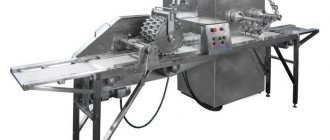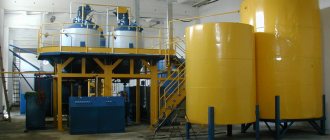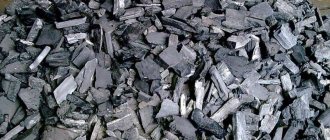What stores does a person visit every day? Of course grocery! Among the abundance of different products these days, we always buy canned goods. Not a single trip is complete without stew; housewives add canned vegetables or fish to delicious salads. Such canned products undoubtedly have two main advantages: cost and long storage. A properly built business in this area will bring its owner good income.
The stores are mostly stocked with imported products. The production of canned fish is more developed than that of meat. This can be corrected if domestic producers process the national product. You can become such a manufacturer. A canned food production plant will not bring quick profits. Here it is important to find and interest a buyer with your high-quality and exclusive product.
Where to start production
Production must begin with the organization of a workshop. It is necessary to analyze the work of competitors and production technology. It is better to open a cannery near big cities. There will be good demand for manufactured products. You need to find suppliers for your workshop and conclude contracts, draw up a business plan for the volume of products produced. Canned goods have always been in great demand. Housewives make preparations for the winter, but not everyone has the time and energy for this. It’s easier to go to the nearest store and purchase the product you need. But what should we release so that the product is in demand? Decide on the type of canned products produced.
Types of canned vegetables:
- vegetables in marinade; canned snack foods (salads, stews); canned tomatoes (ketchup, puree, paste); juices
Canned meat raw materials:
- offal;
- meat products;
- poultry meat;
- meat and vegetable.
Canned fish meat:
- in its own juice;
- in tomato sauce;
- In oil;
- fish and vegetable;
- unsterilized canned fish.
Recruitment
The founder of the plant is assigned the role of manager. In an enterprise that is associated with the production of food products, an important employee is considered to be a technologist. He monitors the production of products and compliance with the necessary technologies.
You cannot do without other necessary specialists. The workshop must have a boss, a product sales manager, a storekeeper, several loaders and machine operators. The number of personnel depends on the volume of products produced.
Premises requirements
Workshops for canning products must have an area of at least 300 square meters. m. This area will be quite enough for a warehouse and equipment. In addition to production workshops and warehouses, the following premises must also be present:
- refrigeration;
- administrative;
- household.
Purchase of raw materials
Before purchasing all equipment, double check the raw materials supplied. It must be of high quality. It is better to purchase products from large farms. Farmers will also benefit from such a deal. They will have a place to sell their products, and you will have selected products. If you make canned vegetables, then the purchase of raw materials will occur in season. But remember that vegetables such as peas and corn freeze well. Therefore, refrigeration units must definitely be installed in your mini-factory. Any product that has difficulty freezing should be placed in a vegetable store. Proper storage of products is an additional plus for your capital.
Financial calculations
Start-up capital
Start-up investments in organizing a conservation workshop consist of small organizational costs (up to 10 thousand rubles), purchase of equipment (from 3 million rubles for a semi-automated line), renovation of the premises in accordance with sanitary standards (about 1 million rubles), examination and certification of samples (about 10 thousand rubles for each item). The total cost of the initial stage is just over 4 million rubles, the productivity of such a workshop will be about 35 thousand liter cans of canned food per month.
Monthly expenses
Operating expenses make up a large share of production costs. On average, ready-made canned food contains about 43% vegetables, the rest is filling, spices, and seasonings. Thus, to ensure monthly production capacity, at least 15 tons of vegetables and fruits (15,500 kg including spoilage and rejection) will be required. With an average purchase price of a ton of raw materials per season of 25 rubles/kg, at least 400 thousand rubles will need to be spent monthly on fruit and vegetable products. Another 350 thousand rubles. will include costs for glass containers, lids and pallets for packaging.
Renting the premises and the cost of water and electricity consumption will cost 100 thousand rubles. and more, depending on the region and location of the workshop. Payment of production personnel at a rate of 25 thousand rubles/month. will be 260 thousand rubles. along with taxes and contributions to funds. To pay the remaining taxes, you need to plan another 40 thousand rubles. Thus, monthly production costs will be at least 1.15 million rubles.
How much can you earn?
Profitability on production when sold at a wholesale price of 50 rubles. per kg of canned products will be 1.75 million rubles per month. Net profit – 600 thousand rubles. per month will be subject to seasonal fluctuations, tending to zero in the summer and doubling on the eve of the New Year holidays. Taking into account all factors, the initial annual profit should be planned at the level of 2-3 million rubles, which means that the initial investment will only be recouped after two years of successful operation.
Requirements of the sanitary and epidemiological station
The requirements of the sanitary and epidemiological station at an enterprise that is associated with the production of food products are very serious. Their violations lead to disastrous consequences. Personnel are required to have a health certificate and undergo an annual medical examination on time. Clothing must be specialized. Gloves are a must too. The building itself where canned food is produced must be located no less than 500 meters from the residential area, have a connection to sewerage, water and access to the workshop. Cleaning of all premises and equipment must be daily and of high quality. All batches of the manufactured product must have their own certificates of conformity.
Requirements for preservatives
There are several main methods for producing canned food, the most common of which are their physical and chemical varieties. It is no secret that modern products of this kind contain many preservatives. In principle, this has been the problem with the entire production of canned foods, ever since they began to be produced on an industrial scale.
These substances are subject to special requirements: they must be completely harmless, not affect the original taste of the product, and be excreted from the human body unchanged. Unfortunately, none of the common preservative agents immediately meets all the requirements.
Main range of products
Even a small cannery has great productivity. When organizing the entire process, you need to focus on the market and consumers.
A specialized workshop can produce the following canned food:
- meat;
- fish;
- vegetable.
In order for such an enterprise to have a good profit, it is necessary to produce products of very good quality, which would be similar to homemade products. Then the consumer will buy your product again and again. When delivering to stores, you should focus on the average buyer.
Features of a business idea
A mini-plant of this specialization does not have high productivity, so when organizing it you need to focus on the needs of the local buyer. When locating the capacity of a mini-enterprise, it is necessary to pay attention to the availability of raw materials in order to reduce transportation costs. This will reduce the cost of production.
Mini canned food production plant
As a result, it will become competitive with the products of large manufacturers that have gained the trust of many buyers.
A mini-factory can focus on the production of the following types of canned food:
- meat;
Types of canned food - fish;
- vegetables – green peas, beans, corn;
- mushrooms;
- fruit juices;
- pickled cucumbers, tomatoes, bell peppers;
- eggplant and squash caviar;
- a variety of vegetable salads;
- tomato sauce and pasta;
- vegetable soups;
- fruits - apples, apricots, peaches, etc.
To make a profit from such an enterprise, it is necessary to produce high-quality products that could compete with homemade products. It is also worth considering that the level of profitability of such a plant depends on the wealth of customers.
Another feature of mini-factories is that their operating hours are seasonal. The production of canned vegetables and fruits occurs in the summer-autumn period, and sales - in the winter-spring. If desired, you can set up several lines. One of them should be engaged in the production of meat, fish or mushroom products. Such a line can operate for a whole year.
Processing and canning of fruits and vegetables
Production process
Canned food is one of the most popular and purchased products. Their production process is quite complicated. It is divided into several stages.
Production of canned products from raw meat:
- cutting meat into portions;
- product vacuum;
- canning;
- checking cans for air ingress;
- temperature exposure;
- labeling of finished products.
The cooking technology may vary depending on the types of canned food (stew, pates). The resulting product is sent for seaming after mandatory control weighing. The tightness is checked by immersing the cans in boiled water. Sterilization is necessary for long-term storage. The labeling must contain the following data: time, date of manufacture, batch number, grade, place of production.
Canned fish comes not only in oil and unsterilized. You can also produce products in tomato, from fried fish, and produce mixed canned food (fish and vegetables).
First, the fish is kept in special chambers with ice, after which it is cut up and all unnecessary parts are removed. Canned fish in its own juice is made from fresh, chilled or frozen fish. Then the product also enters a vacuum sealing machine and goes through the stage of leak testing and thermostatic holding. Completely finished products are kept in the warehouse for a month, after which they are delivered to stores.
In the shops where vegetables are canned, they are first sorted, then washed and sent for further processing. Some are run through special machines that remove peels and seeds from vegetables. Then they cut or rub through a sieve.
Heat treatment of vegetables includes: sealing, blanching, frying, sautéing. Blanching is a heat treatment that preserves the color, taste and aroma of the product. Blanching temperature is not lower than 75 degrees. When frying raw materials, the volume of vegetables decreases; this must be taken into account. Sauteing creates a crust because the temperature is lower than frying.
Business concept
Canned food is produced by pouring vegetables or fruits with special solutions and then sterilizing them in a sealed container. Solutions can be spicy, salty, sour, sweet, consist of water or juices, and contain preservatives and dyes. Depending on the selected recipes, the brand’s assortment matrix is formed.
The technological process is multi-stage and easily amenable to automation. However, the costs of purchasing automated lines are many times higher than the costs of paying for manual labor over the estimated life of the equipment. Therefore, many factories continue to use outdated equipment and a huge number of personnel - up to 300 people for a small enterprise.
The process begins with thoroughly cleaning vegetables and fruits from contaminants. Next, the raw materials are crushed in accordance with the recipe or left whole, rejected while moving along the conveyor and subjected to heat treatment with the addition of all the necessary ingredients. The resulting product is poured into jars, sealed and sterilized in autoclaves for 0.5-1 hour at a temperature of more than 100 degrees Celsius. A label is placed on glass, tin or cardboard containers containing the finished product. Products are packaged in pallets with polyethylene and stored until shipment in dry rooms with the ability to regulate temperature and humidity levels.
Production and sales are seasonal in nature, associated with harvest dates in the region where raw materials are purchased, so warehouse space sufficient for the annual production capacity is required.
The production of canned food is also possible from frozen vegetables and fruits; in this case, the purchase of freezing equipment for storing raw materials will be required, as well as an increase in logistics costs through the use of refrigerated transport. The use of imported fruit and vegetable products in the current economic conditions is unprofitable and is used by enterprises only to expand the range by including canned exotic fruits.
Selling ready-made canned goods may cause some difficulties. This area is characterized by a strong competitive base formed by large holdings in the southern part of the country. To make a profit in this environment, SMEs should focus on more specific niches:
- production for own brands of large retail chains - high capacity, no sales problems, but low selling price;
- production of products unique to the market (without preservatives, without sugar, according to special recipes, for certain categories of buyers) - small volumes at a high price, but high marketing costs;
- a full-cycle enterprise in agricultural farming - no seasonality in making a profit, stable quality of raw materials, but dependence of production on harvest volumes.
The chosen production format has a significant impact on the volume and quality of purchased raw materials, the ratio of ingredients, market positioning, and only to a small extent on the stages of the technological process and the selection of equipment. At the initial stage, this allows you to diversify your product line, track consumer demand and repurpose an existing enterprise without additional costs.
Equipment
Without equipment, nothing will work at a cannery, so it’s worth purchasing everything you need. You will need:
- equipment for the production of lids for canning;
- autoclaves;
- washing equipment;
- steam generators;
- conveyor lines;
- packaging machines.
Equipment manufacturers offer automated lines, the cost of which depends on functionality and power. For example, a kit for rolling canned vegetables will cost 2 million rubles. Fully prepared equipment for the production of canned meat will cost 10 million. It is very difficult to draw a specific conclusion on equipment costs, since everything will depend on your activities.
Competitiveness and product sales
The second important point for the success of a canned vegetable business is the presence of stable sales channels. And here there are two options: creating your own retail chain or selling products in supermarkets and large retail outlets.
The most acceptable and effective option is cooperation with large trading companies that operate on the market not only in a certain region, but throughout all cities of Russia, which significantly expands the opportunities of any entrepreneur. But, unfortunately, it is almost impossible to break into such a market. Such companies themselves often act as importers of various canned goods, so in fact you will act as a competitor for them, and not as a profitable partner. And with all this, they work in the lowest price segment.
But, no matter how strange it may sound, it is quite possible to turn such obvious disadvantages into fat advantages.
What can be done:
- Invite companies to sell your product under their brand. Buying from a domestic manufacturer, that is, from you, will be five times more profitable than from foreign companies, so profitability will certainly be the final argument in your favor, especially if the product you offer is truly high-quality.
- To exclude competition with the company’s own products, offer a range of products that will differ from those already on the market, but based on the characteristics of the national cuisine of the Slavs. To implement such a task, you will need to hire a professional technologist who will develop a new recipe for canned food, but such expenses will quickly pay for themselves.
Packaging, labeling and storage
The packaging must include artwork and text on the label. It must be produced by printing or gluing to containers. The label must be neatly pasted, clean and intact. The text should indicate the expiration date, volume of products, where the production is located, the designation of the regulatory document for the product and the barcode.
Cans, bottles, tubes and other containers are used for packaging. Packages with manufactured products must be intact and clean.
Plant equipment
A vegetable processing complex for a mini plant must have the following technical characteristics:
- raw material processing capacity – at least 100 kg/hour, preferably up to 500 kg/hour;
- The area of the premises for installing the production line is about 100 square meters. m.;
- Electricity consumption – up to 70 kW/hour, water – up to 1 cubic meter. m./hour;
- The staff of service personnel is about 10-16 people.
A packaging line is also required. The following types of packaging should be used: glass jars with capping lids, glass bottles, vertical bags, plastic cups, trays.
Packaging volume from 0.06 to 10 liters.
Range of products
The following list of products should be considered as a range of products.
But at the same time, it is worth immediately making a reservation that, as already mentioned above, when choosing an assortment, an entrepreneur should focus exclusively on his personal experience, the state of the market, and the presence of imagination.
- canned vegetables, including vegetable caviar, salads, lecho, sliced and stuffed vegetables in tomato sauce;
- ready-made meals from vegetables with the addition of meat;
- semi-finished products that need to be heated before use (stuffed cabbage rolls, meatballs);
- vegetable purees;
- sauces and vegetable pastes;
- smoothie made from fruits and vegetables with the addition of nuts and cereals;
- dried fruits;
- candied fruits, etc.
The cost of a production line for processing vegetables on the market is about 3.5 million rubles.
Sales of finished products
The question that concerns all managers of mini-canning factories is where to supply their products. The most relevant would be to create your own sales network. The products can be sold to markets, cafes, restaurants, and sanatoriums. To increase your competitiveness, you can come up with your own recipes for interesting dishes of Oriental, Kuban, and Georgian cuisines.
All business activities related to the food industry carry certain risks. But if you follow all the rules and produce high-quality products, then the profit in such a business will be good. The most difficult thing is to organize production and correctly calculate the costs of it. We recommend looking at existing canned meat manufacturers and conducting competitive intelligence.
11.03.2020
Prospects for a business idea
The main advantage of this type of activity today is the fact that absolutely all farmers who grow vegetable crops experience an acute lack of sales markets. If, for example, any root vegetables, including potatoes, carrots or beets, can be sold for a long period of time, then the bulk of vegetables have a shorter shelf life and, accordingly, should be sold as early as possible. Therefore, many farmers are forced to take completely extreme actions; they either completely refuse to grow such perishable products as tomatoes, cucumbers, peppers, or limit themselves to only very small areas for these crops. But if you provide such farms with a stable market, which any cannery can do, then things will be completely different.
At the same time, the mini canning plant will also be fully supplied with raw materials. And this will be a fairly cheap raw material, since at the peak of yield the prices for such agricultural products are minimal.
Another advantage of the business idea follows from the above - today the cannery will have virtually no competition in the market. There is no need to worry that you will not be able to compete with such market giants as Baltimore or Bonduelle, because you won’t have to do this at all. The fact is that these well-known brands operate in our market according to the following scheme: only 4 months a year they are manufacturers, and the rest of the time they act only as importers. And it’s quite possible to take advantage of this circumstance.
How to do it:
- During the winter season, it is necessary to establish the production of exclusive products, including various pickled vegetables with sauces in the form of ready-made snacks (mushrooms, eggplants, cucumbers, etc.), stews, lecho. The assortment in this case is limited only by the imagination of the manufacturer and the peculiarities of the national cuisine.
- In the cold season, you can retrain for the production of ready-made canned lunches, including cereals with vegetables and various salads.
Important. Companies that specialize in the production of salads make the greatest profits during the winter seasons. But your company will have a significant advantage here, too, because “salad” companies produce their products with a minimum shelf life (no more than 3-4 days), while your products will have a shelf life of up to 6 months.
As we see, such a business has very real prospects, and therefore we can safely begin planning the implementation of this idea.
Production costs and operating income
It is best to calculate expenses and income from activities taking into account the fact that the main production cycle is 4 months in the warm season, because when calculating income from additional types of income (making salads and ready-made meals) in the winter, you can get a distorted and not entirely exact information.
For the basic unit of profit in a specific example, we will take 1 kilogram of frozen peas.
Costs per production cycle:
- Peas (or any other vegetables) - 120 tons (1 ton of product is processed per shift, 30 tons per month, respectively, 4 months - 120 tons). The purchase price is 2.4 million rubles (the price of 1 ton is 20 thousand rubles).
- Electricity - 30 thousand kW (per shift - 250 kW, per month - 7.5 thousand kW, for 4 months - 30 thousand kW). The cost of electricity is 96 thousand rubles (the price of 1 kW/hour is 3.2 rubles).
- Payroll fund – 1.5 million rubles for 4 months.
- Rental of production space – 1.2 million rubles (100 thousand rubles per month * 12 months).
Total expenses: 5.2 million rubles.
Income from activities:
- The cost of selling 1 ton of peas is 100 thousand rubles.
- The income from the sale of 120 tons of frozen peas is 12 million rubles.
Net profit: 6.8 million rubles.
Return on investment: during the first season of activity (the first 4 months of the season).
Production profitability: about 40 percent.
A mini canning plant is a very profitable business. And the example we have considered is just one more piece of evidence in favor of this statement, so if you have all the necessary prerequisites for bringing this idea to life, it is not possible to doubt the prospects.
The idea of opening a workshop for the production of canned vegetables at first glance seems banal and unpromising. However, upon closer examination, you will understand that this is absolutely not the case and your own production of canned vegetables has every chance of turning into a highly profitable business.
First plus
The fact is that absolutely all farms specializing in vegetable growing experience an acute lack of a market for their products. While carrots, beets, cabbage and potatoes can be sold over a long period of time, crops such as green peas, sweet corn, peppers, cucumbers and tomatoes are either not grown at all or grown in very limited quantities. And if such farmers are provided with a stable sales market, and a mini-factory for the production of canned food is what is needed, then its owner will receive:
- Unlimited amount of raw materials capable of loading all production capacities at 100%.
- Raw materials received from farmers at the peak of the harvest will cost the manufacturer very little, and this means low production costs.
Second plus
A similar idea applies to competition. It would seem that it is practically impossible to beat such large companies or Bonduelles in this business. However, this is not necessary! In fact, all these representatives of famous brands in Russia are manufacturers only 4 months a year, and then they become ordinary importers with a very limited range of goods. And this circumstance must be taken full advantage of:
- the production of exclusive
during the cold season . For example, ready-to-eat dishes such as: mushrooms in sour cream, pickled eggplants in mushroom or sour cream sauce, cucumbers in tomato, etc. The range of such products is limited only by imagination and the peculiarities of national cuisine. - The second is to retrain for this period as a manufacturer of salads
of both oriental and traditional cuisine, as well as produce ready-made meals; fortunately, the equipment below will allow you to set up such production without any problems. The so-called salad companies make their main profits at this time of year. And even here you will find yourself out of competition, since you will master modern technologies for canning salads and lunches, the shelf life of which will range from 2-6 months, while for salad companies it is a matter of days.
We’ve sorted out the business prospects and now let’s move on to specific actions, namely: we’ll identify a number of problems and find solutions to the most important issues that accompany the opening of a mini-factory for the production of canned foods.
Select the appropriate option
| Standard | Advanced with financial calculations with Excel financial model | Expanded with adjustments |
| Standard business plan | Extended cannery business plan with full business analysis and financial plan for 5 years | Extended cannery business plan with full business analysis and financial plan for 5 years |
| Detailed financial model of a cannery | Detailed financial model of a cannery | |
|
| |
| Adjustment of the business plan to your numbers by our analysts within 5 working days | ||
| Business plan volume: 30 pages. | Business plan volume: 80 pages. | Business plan volume: 80 pages. |
| 10,000 rub. | 20,000 rub. | 39,000 rub. |
| RUB 1,390 | RUB 2,950 | RUB 24,990 |
| Buy | Buy | Buy |
This kit is ideal for those who need a business plan to obtain a loan or attract investment.
DescriptionContentsTables and graphsPayment and delivery
Description
The extended business plan includes a financial model of the cannery in Excel format.
The business plan was developed taking into account the practice of evaluating projects in Russian banks, as well as taking into account the requirements of investors and funds for supporting entrepreneurship in the Russian Federation. It will allow you to justify management decisions on investing in the creation and development of a cannery, predict its financial results and assess risks.
A full description of the business plan can be downloaded from the link:
Description of the cannery business plan.pdf
Content
To view the content, download the file:
Description of the cannery business plan.pdf
Tables and graphs
To see the list of tables, graphs and diagrams, look at the file:
Description of the cannery business plan.pdf
Payment and delivery
You can pay in the following ways:
- Bank cards (Russia)
- Electronic money
- Terminals and communication salons
- Money transfers
- Bank cards (International)
Submitting a business plan and financial model:
Dispatch is carried out within 24 hours after payment to your email address.
Business organization
Canned goods are an indispensable food attribute for those who have little time to cook on their own, as well as simply delicious products that allow you to diversify your table. Organizing an enterprise is a labor-intensive process; it is necessary to understand many issues and carefully plan everything. Don't neglect a good cannery business plan.
Stages of organizing activities:
- In-depth market analysis of competitors, suppliers of raw materials and buyers of finished products.
- Determining the direction of work.
- Attracting financing.
- Organization of construction and installation works.
- Equipping the plant with equipment and machinery.
- Attracting qualified personnel, incl. technologist
- Development of technological work maps.
- Preparatory activities.
- Reaching agreements with suppliers and buyers.
- Start of work.
Implementation and competition.
The second prerequisite for success in the production of canned vegetables is stable sales channels. And here two ways are outlined: creating your own marketing network or using the network of large trading companies. With the first option, everything is clear - this is a local market, represented by small grocery stores and supermarkets, to which you need to offer your products using a variety of marketing tricks. But with trading companies things are different.
It is almost impossible to get there with your goods. The fact is that for trading companies you are a direct competitor, since in fact many of them are themselves importers of canned vegetables, on the cans of which they stick labels with their trademark. Moreover, all of their products are in the low price segment, and these two circumstances, if desired, turn from a minus into a huge, fat plus for you.
- First, invite the company to use your product under their brand. Indeed, according to research on the market for canned products, wholesale purchases of domestically produced canned vegetables are 20% cheaper than imported ones. And getting even more profit has always been the decisive argument of any commercial transactions.
- Secondly, in order not to compete with the products of the company itself, throw on the market a product that is not familiar to consumers, but at the same time based on traditional dishes of Slavic cuisine. In this case, you will be helped by a professional technologist who is able to develop both a product recipe and technical specifications.
We have dealt with all the steps preceding the successful organization of a business and now we move on to equipment, initial investment and, of course, profit.











